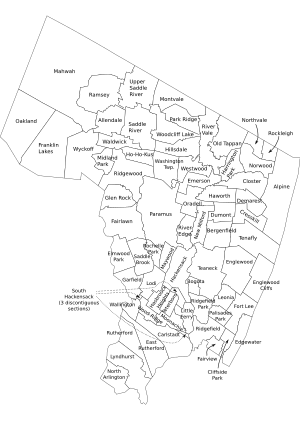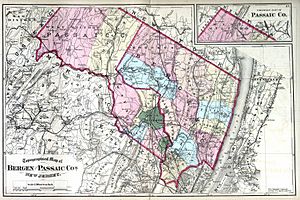Boroughitis facts for kids
Boroughitis (also called borough fever or borough mania) was a time in the 1890s when many small towns, called boroughs, were created in New Jersey. This happened mostly in Bergen County. It was often decided by a vote of the people, called a referendum.
Back then, New Jersey had large areas called townships. As more people moved to New Jersey to live in commuter suburbs (places where people live and travel to work in a bigger city), they wanted more services like better roads and schools. But the farmers who had lived there a long time worried about higher taxes.
New laws made it easy for parts of townships to break away and form their own boroughs. This helped communities get more control over their local schools or gain a seat on the county government board. This is why New Jersey still has so many small towns today.
Why So Many Boroughs?
In the late 1800s, New Jersey was mostly made up of large townships. In Bergen County, many of these townships had new neighborhoods growing around train stations. These were homes for people who traveled (commuted) to work in nearby cities like New York City.
These new residents wanted more government services. They wanted good streets, better roads, and better schools. But the older residents, like farmers, didn't want these changes. They knew that more services meant higher taxes, which they didn't want to pay.
A law already existed that let small parts of townships vote to become independent boroughs. This law wasn't used much at first.
New Laws Make a Difference
In 1893, a political party called the Republicans gained control of the state government. The next year, they passed new laws that changed everything.
One law in 1894 allowed boroughs formed from parts of two or more townships to elect their own representative to the county government, called the Board of Chosen Freeholders. This was a big deal because it gave these new boroughs more power.
Another law, passed later in 1894, said that all the small school districts within a township would combine into one big school district. However, it also said that each city, borough, or incorporated town would be its own separate school district. This meant if a community broke away to form a borough, it could keep control of its local school. This was a huge reason why so many communities decided to become boroughs.
Wealthier communities, especially, didn't want their school tax money to be shared with poorer areas in the larger township. By becoming a borough, they could keep their school funds for their own students.
The Borough Boom
Because of these new laws, 40 new boroughs were created in 1894 and 1895. Most of them were in Bergen County. Townships there were broken up or became much smaller.
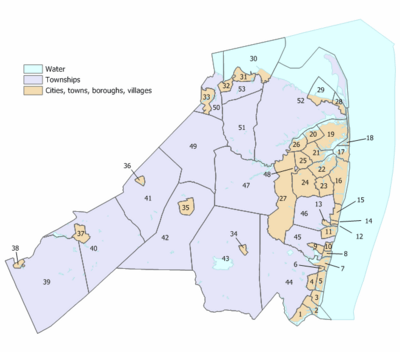
For example, Allendale broke away from Franklin Township because of worries about school funding. Other towns like Park Ridge and Oradell also became boroughs. Some communities, like Delford (which became Oradell), wanted to avoid high taxes for new paved roads, called macadam roads.
One interesting story is about Wood-Ridge. When its residents wanted to form a borough, they carefully drew the boundary lines to exclude the home of a family who didn't want the borough to form. But once Wood-Ridge was officially a borough, they simply added that farmhouse to their town!
The creation of so many boroughs caused some problems. For instance, in Bergen Township, so many parts broke away (like Carlstadt, Moonachie, and Wallington) that the township was left with just a small piece of swampy land and only 61 voters. It was later added to Lodi Township.
There were even some fights and disagreements. One story tells of a man whose house was on the new border between Teaneck and Bogota. His house caught fire, but firefighters argued about which town had the right to put out the fire, and the house burned down.
What Happened Next?
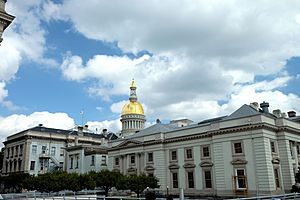
The "borough craze" continued into 1895. But people started to realize the problems. The county government in Bergen County grew from 16 members to 28, which meant higher costs.
In 1895, the state government changed the laws again. They made it harder to form new boroughs by requiring more landowners to agree to the petition. They also said that new boroughs couldn't have their own separate school system unless they had at least 400 children.
Finally, in 1896, the state legislature passed a law saying that no new boroughs could be formed just by a local vote. From then on, new towns could only be created by a special law passed by the state legislature itself. This stopped the "boroughitis" boom.
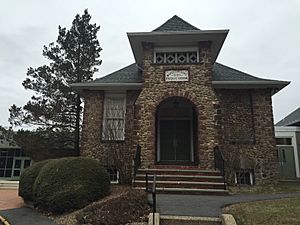
Even after 1896, new towns continued to be created by the legislature, especially in the 1920s. Sometimes this happened because of arguments over money for roads. For example, Caldwell Township in Essex County split into six towns by 1908.
By the 1920s, Bergen County had 70 towns, which is how many it still has today. Because of boroughitis, the township form of government almost disappeared from Bergen County. One township that remains is South Hackensack, which is made up of three separate pieces of land that no other borough wanted.
Today, New Jersey has 564 towns (municipalities). This is more than eight other states combined, and it has the most towns per person of any state. Some of these boroughs are very small, like Teterboro in Bergen County, which has an airport and businesses but fewer than a hundred residents. Another is Tavistock in Camden County, which is mostly a country club.
Some leaders have suggested combining towns to save money, but it's hard to do because people like having their own local government. The many small towns in New Jersey are a lasting result of the "boroughitis" craze from the 1890s.


